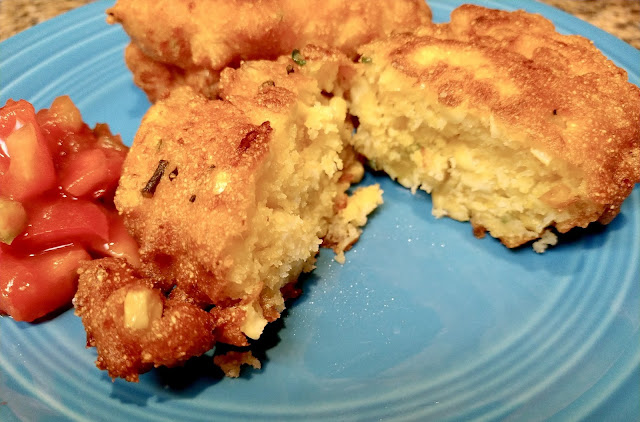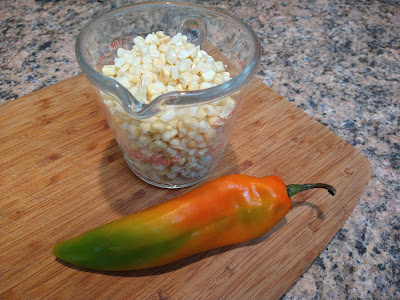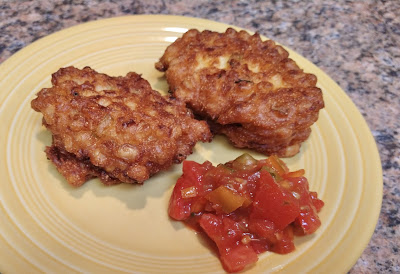
Recipe: Corn-chile fritters with Southwest flavor
 |
| These fritters are full of whole corn yet light and fluffy. (Photos: Debbie Arrington) |
October is the end of fresh corn season. Big ears are packed with full-flavored kernels.
These savory fritters make the most of sweet, chewy corn cut off the cob. (It takes about two ears to produce 2 cups of kernels.) The batter is similar to a cornmeal hush puppy with 2 teaspoons of baking powder; the fritters expand rapidly in the pan.
Giving these fritters Southwest flavor are four C’s: Corn, chiles, cheddar and chives. That combination is a great addition to cornbread, too.
Good for brunch, lunch or dinner, these fritters are served warm with salsa and sour cream, if desired. Surprisingly light and fluffy, they’re tasty plain, too.
 |
|
Fresh corn season winds down but isn't gone yet.
|
Corn-chile fritters
Makes about 10 fritters
Ingredients:
¾ cup cornmeal
½ cup flour
2 teaspoons baking powder
½ teaspoon salt
1 teaspoon sugar
¾ cup milk
1 large egg
2 cups corn kernels
¼ cup chile pepper, finely chopped
2 tablespoon chives, finely chopped
½ cup cheddar cheese, shredded
Shortening or vegetable oil as needed
Instructions:
In a large bowl, mix together cornmeal, flour, baking powder, salt and sugar.
Beat together milk and egg; add to dry ingredients. Mix together to make a thick, but smooth batter. Add a tablespoon or two of milk if necessary. Stir in corn kernels, chile pepper, chives and cheese.
In a large, deep and heavy skillet or saucepan, melt shortening or heat oil over medium high heat. Use enough shortening or oil to reach 2 inches deep. Make sure skillet or pan sides are high enough that hot oil doesn’t splatter out of pan. Bring melted shortening or oil up to 325-350 degrees F.
Fry fritters in batches. Don’t overcrowd the pan. Drop fritter batter into hot oil by large spoonfuls spaced apart; fritters will expand while frying. Fry until golden brown on both sides, about 5 to 6 minutes total, turning once.
Remove from oil with slotted spoon. Drain on paper towels. Eat immediately or keep warm in a 250-degree F. oven.
 |
|
Salsa is a great accompaniment to the fritters.
|
Serve with salsa and sour cream if desired.
Comments
0 comments have been posted.Sacramento Digs Gardening to your inbox.
Sites We Like
Garden Checklist for week of July 21
Your garden needs you!
* Keep your vegetable garden watered, mulched and weeded. Water before 8 a.m. to reduce the chance of fungal infection and to conserve moisture.
* Feed vegetable plants bone meal, rock phosphate or other fertilizers high in phosphate to stimulate more blooms and fruiting. (But wait until daily high temperatures drop out of the 100s.)
* Don’t let tomatoes wilt or dry out completely. Give tomatoes a deep watering two to three times a week.
* Harvest vegetables promptly to encourage plants to produce more. Squash especially tends to grow rapidly in hot weather. Keep an eye on zucchini.
* Pinch back chrysanthemums for bushy plants and more flowers in September.
* Remove spent flowers from roses, daylilies and other bloomers as they finish flowering.
* Pinch off blooms from basil so the plant will grow more leaves.
* Cut back lavender after flowering to promote a second bloom.
* It's not too late to add a splash of color. Plant petunias, snapdragons, zinnias and marigolds.
* From seed, plant corn, pumpkins, radishes, winter squash and sunflowers.